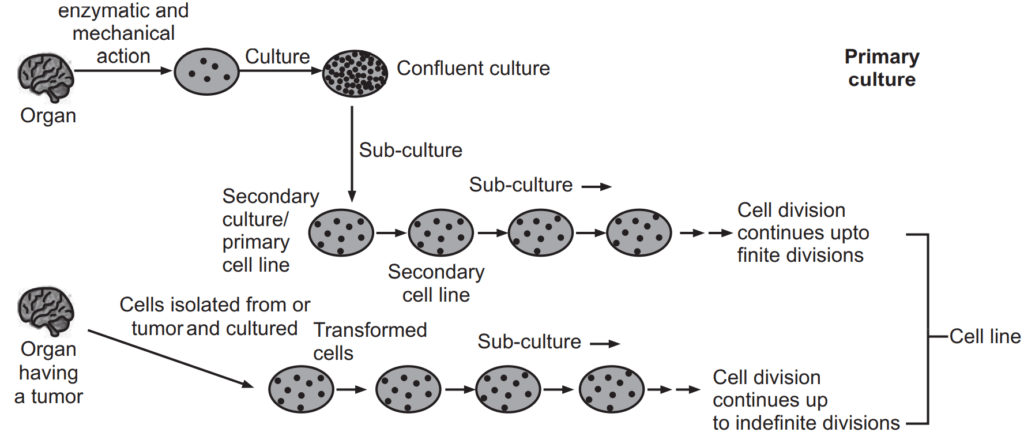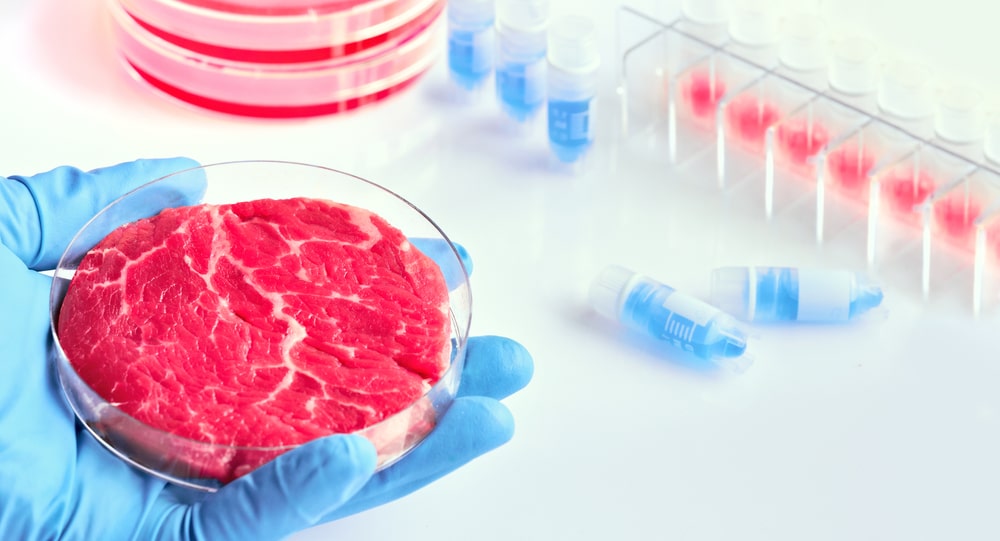The general procedure for cell culture is given in figure 1.1.
Table of Contents
Essential for cell culture
Requirements: Vertical Laminar air flow, Incubator, Refrigerator, Microscope, Tissue culture ware.
Temperature: The temperature sets at the same as the body temperature of the host from which cells are procured. Most animal cells required 36-37o C.
Substrate: Good compatible substrate is required for attachment and optimum growth. Glass and specially treated plastics are commonly used as substrate. Thereafter attachment factors such as collagen, gelatin, laminin, etc. are used as substrate coating to improve the growth and function of normal cells derived from the brain, blood vessels, kidney, liver, skin, etc.
Culture medium: It is an important and complex factor for cell growth. The culture medium is supplemented with various growth factors, pH, and osmolality regulators and provides essential gases like oxygen and carbon dioxide. The medium is also supplemented with various nutrients like amino acids, vitamins, minerals, and carbohydrates which are essential for the growth of cells and provided energy for metabolism. Choice of media is used based on the cells being cultured. Generally, media like Dulbecco’s modified Eagle’s medium (DMEM), Eagle’s minimal essential medium (EMEM), Glasgow Minimum Essential Medium (GMEM) are used for cell culture. Prepared media is filtered and incubated at 4o C.
Media and growth requirement: Temperature should maintain at 37°C and optimum pH is 7.2 to 7.5. The humidity is required to be maintained properly in the media with a proper gas phase ratio (Bicarbonate concentration and carbon dioxide in equilibrium). For the growth of cultured cells, light intensity also plays a vital role. Inside the environment, cells are cultured in the dark because of the light-induced production of the toxic compound. Commonly used antibiotics are penicillin, streptomycin, Kanamycin, etc. Commonly used fungicides are Nystatin, Amphotericin B. Bulk ions like sodium, potassium, calcium, magnesium, chlorine, phosphorus, carbon dioxide, oxygen, etc. Trace elements like iron, zinc, selenium, sugar, amino acids, vitamins, choline, inositol, etc.
Selection of organs: Different types of cells are grown in cultures including connective tissue elements such as fibroblasts, skeletal tissue, cardiac, epithelial tissue (liver, breast, skin, and kidney), and many different types of tumor cells. On the basis of morphology (shape and appearance) or on the functional characteristics of cells, they are divided into three types.
- Epithelial-like – attached to a substrate and appears flattened and polygonal in shape.
- Lymphoblast – cells do not attach remain in suspension with a spherical shape.
- Fibroblast – cells attached to a substrate appear elongated and bipolar.
Culturing of cells: Cells are cultured as anchorage-dependent or independent. Cell lines derived from normal tissues are considered as anchorage-dependent which grows only on a suitable substrate e.g. tissue cells. Suspension cells are anchorage-independent e.g. blood cells whereas Transformed cell lines either grow as a monolayer or as suspension.
Steps:
- Use sterile technique: Tissue part is harvested and processed using sterile equipment, reagents, and techniques. Personal protective equipment is used to avoid contamination. All enzymes and reagents are filtered sterile condition using a 0.22-micron membrane.
- Mince/cut tissue: Mince the tissue specimen into small pieces (usually 2 × 4 mm) with sterile scissors or scalpel, and then placed the small pieces into the selected buffer, media, or salt solution.
- Wash and add enzyme: Wash tissue two to three times to eliminate excess blood proteins and then add enzyme(s) of choice, likely, collagenase, protease, papain, or trypsin. Usually, about 0.5 to 1.5 mg/ml of the selected enzyme is sufficient.
- Incubation: Further tissue specimen is incubated in optimum temperature at 37°C for 30 to 90 minutes with a periodical mixed rock specimen.
- Disperse and wash cells: Cells are dispersed by gently pipetting them and then cell suspension is filtered using a fine mesh. The cells became settled and decanted excess liquid containing enzymes. Further cells are washed two to three times with Fetal Bovine Serum (FBS), Bovine Serum Albumin (BSA), or other inhibitors that can also be used to halt enzyme digestion.
- Resuspension and measure cells: Cells are resuspended in the correct medium or buffer and then quantitatively determine the cell yield and viability. This is an important step in the cell isolation process to evaluate the result by dissociation technique. Most researchers have used a hemocytometer for determining cell yield and trypan blue diazo dye to measure cell viability.

- Cell toxicity: Cytotoxicity causes inhibition of cell growth which observed an effect on the morphological alteration in the cell layer or cell shape. It is characterized by abnormal morphology like giant cells, multinucleated cells, a granular bumpy appearance, vacuoles in the cytoplasm or nucleus, etc. Cytotoxicity is determined by substituting materials such as medium, serum, supplements flasks, etc.

Primary Culture
Cells when surgically or enzymatically are removed from the organism and are placed in a suitable culture environment and grown are called primary culture. They have a finite life span and contain a heterogeneous population of cells. These cells upon subculture lead to generating cell lines that have a limited life span. The lineage of cells are originated from the primary culture is known as cell strain. Primary cultures are morphologically similar to the parent tissues. They have a limited number of cell divisions (Fig.1.2).

Established Cell Culture
Primary cell culture when first subcultured is known as secondary cell culture. An established or immortalized cell line is the ability to proliferate indefinitely by random mutation and artificial modification such as artificial expression of the telomerase gene.
Advantages:
- Many kinds of cell lines.
- Generally easy to grow and manipulate.
- Proliferate indefinitely.
- Contact inhibition.
Example: HeLa, Sf-9, Cervical cancer.
Transformed Cell Culture
Transformation is a process of conversion of a normal cell into a cell having some or many of the attributes of a different cell. When a cell is transformed, cells lose contact inhibition and become immortal. For example, NIH 3T3 mouse cells are partially transformed and become immortal but contact inhibited and grows in a monolayer. Transformed cells lack contact inhibition of movement due to change of cell surface property and loss of many receptors. They continue to grow and pile up on top of one another as they proliferate.
Transformed cells are also cultured through a suspension medium where cells do not attach to the surface of the culture vessels and are grown liquid culture medium. Hematopoietic stem cells (derived from blood, spleen, and bone marrow) and tumor cells are grown in suspension much faster which do not require the frequent replacement of the medium.
Application of cell cultures in pharmaceutical industry and research
Cell culture is used in cellular and molecular biology, providing excellent model systems for studying the normal physiology and biochemistry of cells (for example metabolic studies, aging), the effects of drugs and toxic compounds on the cells, and mutagenesis and carcinogenesis. It is also used in drug screening and large-scale manufacturing of biological compounds (for example vaccines, therapeutic proteins).
Model System: Cell culture is used as a model system to study basic cell biology and biochemistry. It is also used to study the interaction between cells and disease-causing agents like bacteria, viruses. It helps to study the effect of drugs and to study triggers for aging.
Cancer Research: Cell culture is one of the most important tools in cancer research. The basic difference between a normal cell and a cancer cell can be studied using the animal cell culture technique. Normal cells are induced cancer cells by using radiation, chemicals, viruses, and then the cause of cancer is studied. Cell culture is also used to determine the effective drugs for selectively destroying only cancer cells.
Virology: Animal cell cultures are used to replicate the viruses instead of animals for the production of vaccines. Cell culture can also be used to detect and isolate viruses, and also to study the growth and development cycle of viruses. It is also used to study the mode of infection. This technique is also used for the production of human and veterinary viral vaccines against a variety of diseases.
Toxicity Testing: Animal cell culture is used to study the effects of new drugs, cosmetics, and chemicals and the growth of multiple cells, especially liver and kidney cells. This technique is also used to determine the maximum permissible dosage of new drugs.
Vaccine Production: Cultured animal cells are used for virus production and these viruses are used to produce vaccines. For example Vaccines like polio, rabies, chickenpox, measles, and hepatitis B are produced using animal cell culture. The polio vaccine produced in 1954 was the first human vaccine is produced using large-scale cell culture techniques.
Genetically Engineered Protein: Animal cell cultures are used to produce commercially important genetically engineered proteins such as monoclonal antibodies, insulin, hormones, etc. Proteins extracted from biological sources are important for substitution therapy. Interferon is discovered in 1957 by cell cultured method by viral infection. Tissue plasminogen activator is produced on a large scale from transferred CHO-K1 cells. It is used to prevent fibrin clots in the bloodstream. Blood clotting factor VIII is produced on large scale by Bayer through transfection of the kidney cell line with an appropriate gene.
Replacement Tissue or Organ: Animal cell culture is used as replacement tissue or organs. For example, artificial skin is produced to treat patients with burns and ulcers. Recently artificial organ cultures such as liver, kidney, and pancreas are successfully carried out for transplantation. Organ culture techniques and research are also conducted on both embryonic and adult stem cell cultures. These cells can differentiate into many different types of cells and organs.
Genetic Counseling: Fetal cell culture extracted from pregnant women is used to study or examine the abnormalities of chromosomes, genes using karyotyping, and these findings are used in the early detection of fetal disorders.
Genetic Engineering: Cultured animal cells are used to introduce new genetic material like DNA or RNA into the cell. This method is used to study the expression of new genes and their effect on the health of the cell. Insect cells are used to produce commercially important proteins by infecting them with genetically altered baculoviruses. With this method mass-produced insulin, human growth hormone, human albumin, vaccines, etc.
Gene Therapy: Cultured animal cells are genetically altered and are used in gene therapy techniques. First cells are removed from the patient lacking a functional gene or missing a functional gene. These genes are replaced by functional genes and altered cells are culture and grown in laboratory conditions and are introduced into the patient. Functional gene is inserted into the genome of the viral vector and then they are allowed to infect the patient and the missing gene will be expressed with the help of the viral vector.
Drug Screening and Development: Animal cell cultures are used to study the cytotoxicity of new drugs. This is also used to find out the effective and safe dosage of new drugs. Cell-based assay plays an important role in the pharmaceutical industry. Originally these cell culture tests were done in 96 well plates but recently these tests are conducted in 384 and 1536 well plates.
Make sure you also check our other amazing Article on : Microbial Contamination
